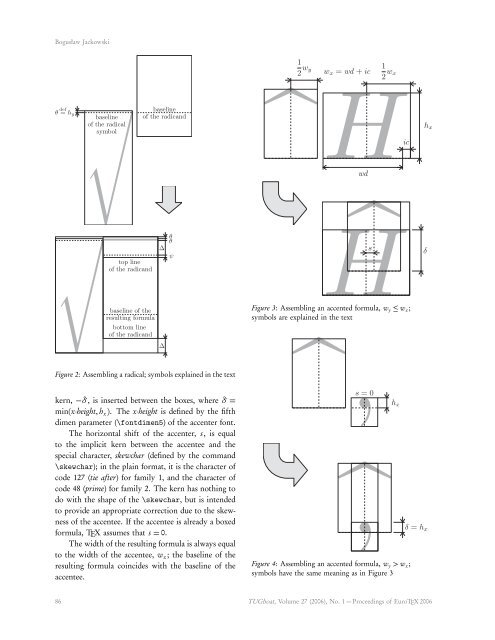Appendix G illuminated - TUG
Appendix G illuminated - TUG
Appendix G illuminated - TUG
Create successful ePaper yourself
Turn your PDF publications into a flip-book with our unique Google optimized e-Paper software.
Bogusław Jackowski<br />
Figure 3: Assembling an accented formula, w y ≤ w x ;<br />
symbols are explained in the text<br />
Figure 2: Assembling a radical; symbols explained in the text<br />
kern, −δ, is inserted between the boxes, where δ =<br />
min(x-height, h x ). The x-height is defined by the fifth<br />
dimen parameter (\fontdimen5) of the accenter font.<br />
The horizontal shift of the accenter, s, is equal<br />
to the implicit kern between the accentee and the<br />
special character, skewchar (defined by the command<br />
\skewchar); in the plain format, it is the character of<br />
code 127 (tie after) for family 1, and the character of<br />
code 48 (prime) for family 2. The kern has nothing to<br />
do with the shape of the \skewchar, but is intended<br />
to provide an appropriate correction due to the skewness<br />
of the accentee. If the accentee is already a boxed<br />
formula, TEX assumes that s = 0.<br />
The width of the resulting formula is always equal<br />
to the width of the accentee, w x ; the baseline of the<br />
resulting formula coincides with the baseline of the<br />
accentee.<br />
Figure 4: Assembling an accented formula, w y > w x ;<br />
symbols have the same meaning as in Figure 3<br />
86 <strong>TUG</strong>boat, Volume 27 (2006), No. 1 — Proceedings of EuroTEX 2006

















